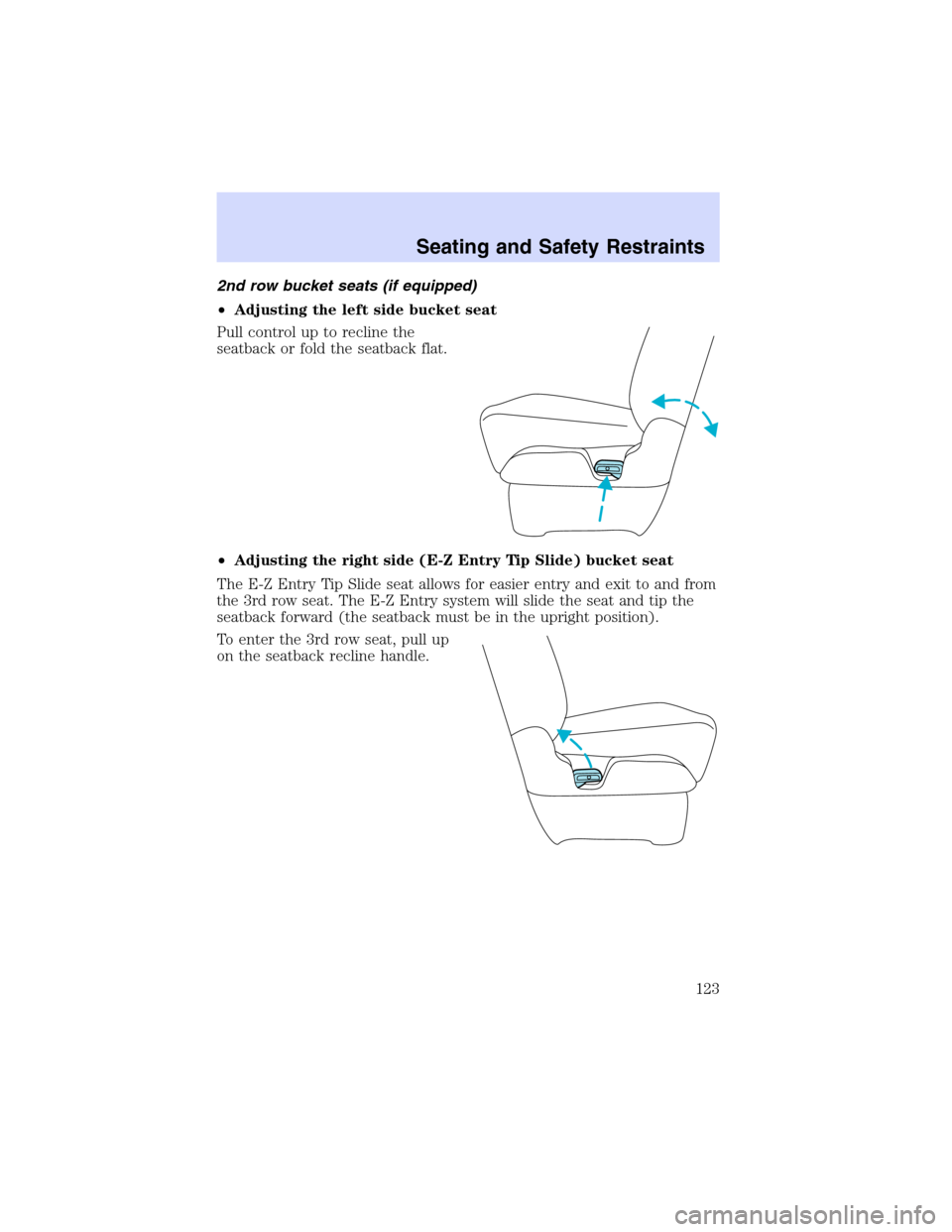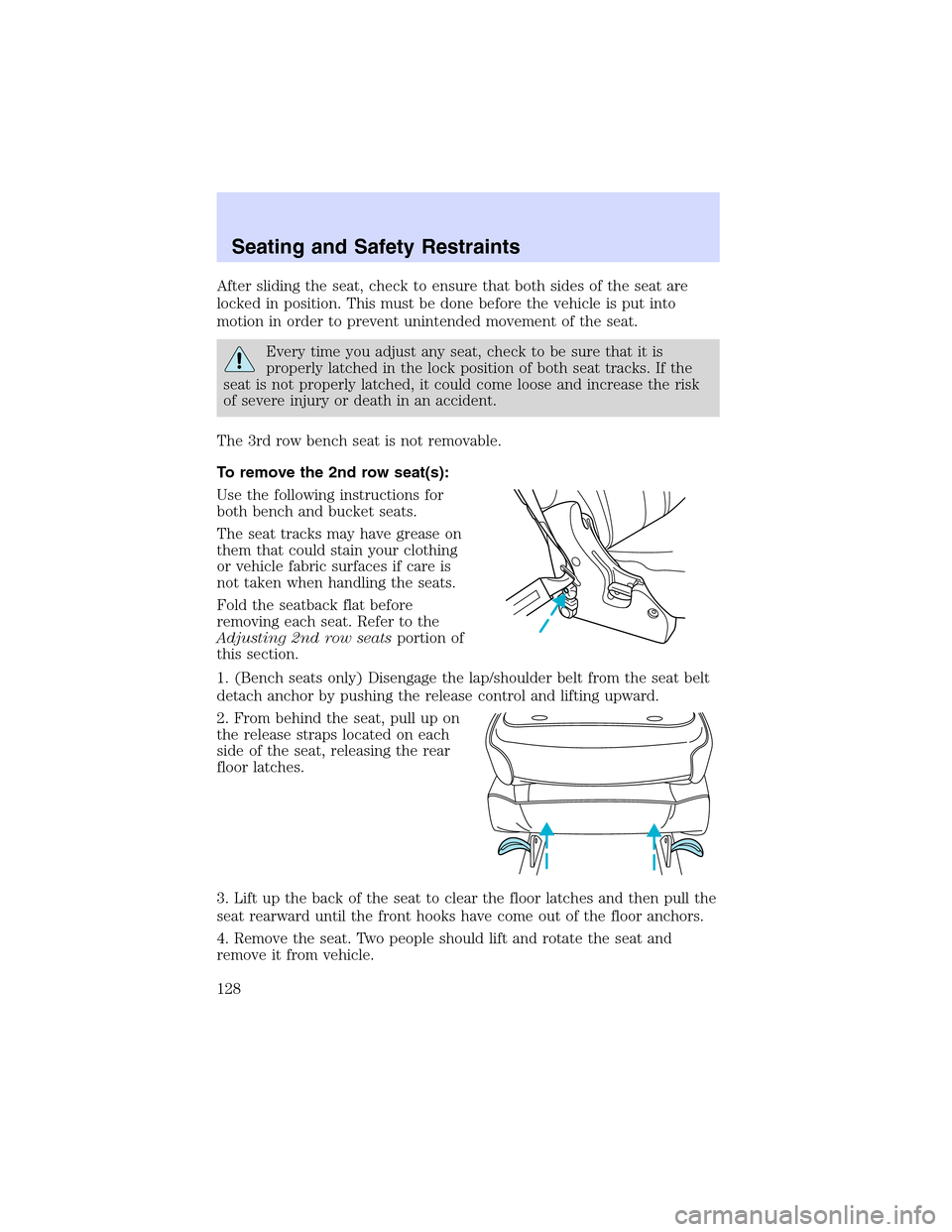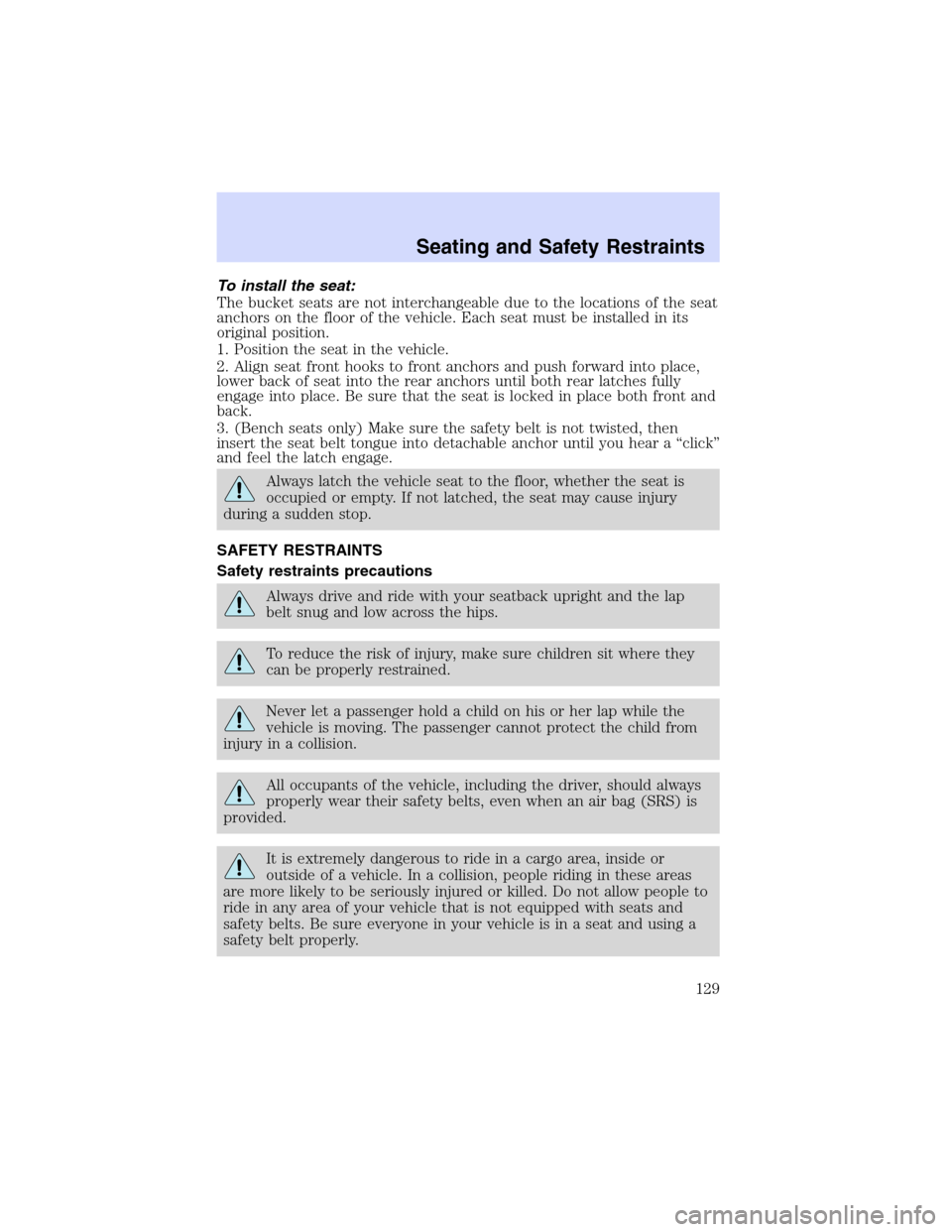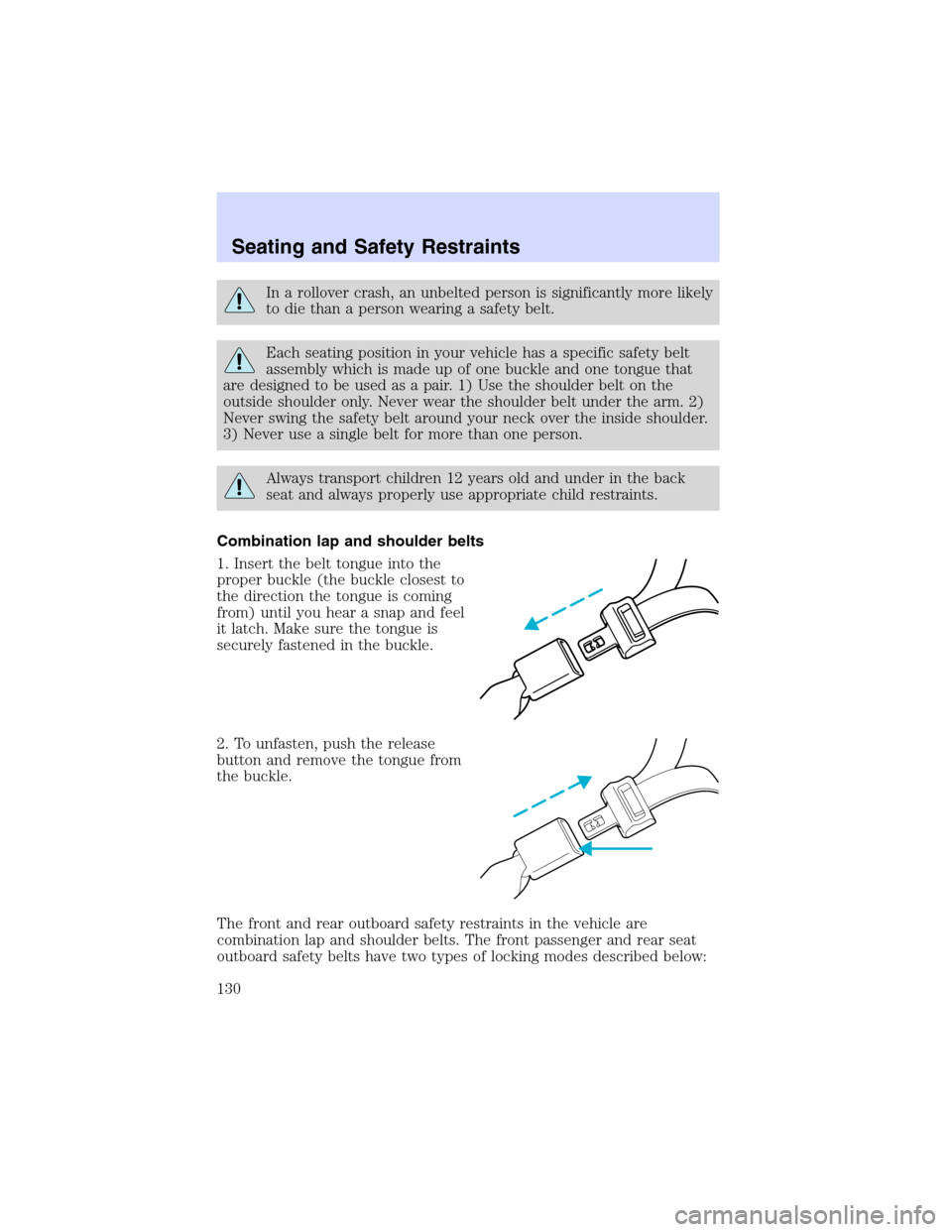Mercury Villager 2002 Owner's Manuals
Manufacturer: MERCURY, Model Year: 2002, Model line: Villager, Model: Mercury Villager 2002Pages: 256, PDF Size: 1.91 MB
Page 121 of 256

B. Narrow mats
•Two passenger vehicle (second row seats removed and third row seat
stored in full forward position—if equipped with Rear Seat
Entertainment System, the third row seat cannot be put into this
position.)
A. Cargo mat (if equipped)
B. Narrow mats
AB
AB
Seating and Safety Restraints
121
Page 122 of 256

Stowed cupholders
The vehicle is equipped with cupholders that pull out from the 2nd row
seat:
•Bench seat - below center of the seat cushion
•Bucket seat (driver’s side only) -
inboard side of seat base
Use only soft cups in the cupholder. Hard objects can injure you
in a collision.
Adjusting 2nd row bench
Pull control up to flip seatback to
forward flat position.
Seating and Safety Restraints
122
Page 123 of 256

2nd row bucket seats (if equipped)
•Adjusting the left side bucket seat
Pull control up to recline the
seatback or fold the seatback flat.
•Adjusting the right side (E-Z Entry Tip Slide) bucket seat
The E-Z Entry Tip Slide seat allows for easier entry and exit to and from
the 3rd row seat. The E-Z Entry system will slide the seat and tip the
seatback forward (the seatback must be in the upright position).
To enter the 3rd row seat, pull up
on the seatback recline handle.
Seating and Safety Restraints
123
Page 124 of 256

To exit the third row seat, pull up
on the 3rd row access control.
To return the seat to a seating position, move the seat rearward until the
seat track locks. Then readjust the seatback.
Lift handle to move the seat forward
or backward.
Seating and Safety Restraints
124
Page 125 of 256

Pull control up to flip seatback to a
forward flat position.
Adjusting 3rd row bench
Pull control up to adjust seatback
position.
This control will also allow the
seatback to be put in the forward
flat position.
Seating and Safety Restraints
125
Page 126 of 256

The entire seat can be moved to four seating positions and two storage
positions.
Before rearranging the seats, remove any floor mats that might be in the
way, seeRemovable floor matsin this chapter for instructions on
placement of floor mats.
For vehicles equipped with a second row bench seat: If the three
passenger bench seat is moved up to the second row position, the
outside passenger (opposite the driver) should fasten the
standard lap/shoulder belt. The secondary seat belt tongue is not
fastened to the outside bottom of the seat (as does the two
passenger bench seat). This is not required with the three
passenger bench seat since the seat is much wider.
The seat tracks may have grease on them that could stain your clothing
or vehicle fabric surfaces if care is not taken when handling the seats.
A. Three rearward seating positions
B. Limousine seating position (3rd row seat with 2nd row seat removed)
C. Two storage positions (If equipped with a Rear Seat Entertainment
System, the second row seat cannot be locked in the forward most
position.)
AC
B
Seating and Safety Restraints
126
Page 127 of 256

To move the seat to another seating or storage position:
1. Lift control (A) to release the
seat cushion and flip the cushion
up. The seat cushion must be
moved to the storage position before
the seat can be moved along the
track.
2. Pull control (B) to move the seat
forward or backward until it locks
into position. The seat cushion
cannot be lowered if the seat is in a
storage position.
A
B
Seating and Safety Restraints
127
Page 128 of 256

After sliding the seat, check to ensure that both sides of the seat are
locked in position. This must be done before the vehicle is put into
motion in order to prevent unintended movement of the seat.
Every time you adjust any seat, check to be sure that it is
properly latched in the lock position of both seat tracks. If the
seat is not properly latched, it could come loose and increase the risk
of severe injury or death in an accident.
The 3rd row bench seat is not removable.
To remove the 2nd row seat(s):
Use the following instructions for
both bench and bucket seats.
The seat tracks may have grease on
them that could stain your clothing
or vehicle fabric surfaces if care is
not taken when handling the seats.
Fold the seatback flat before
removing each seat. Refer to the
Adjusting 2nd row seatsportion of
this section.
1. (Bench seats only) Disengage the lap/shoulder belt from the seat belt
detach anchor by pushing the release control and lifting upward.
2. From behind the seat, pull up on
the release straps located on each
side of the seat, releasing the rear
floor latches.
3. Lift up the back of the seat to clear the floor latches and then pull the
seat rearward until the front hooks have come out of the floor anchors.
4. Remove the seat. Two people should lift and rotate the seat and
remove it from vehicle.
Seating and Safety Restraints
128
Page 129 of 256

To install the seat:
The bucket seats are not interchangeable due to the locations of the seat
anchors on the floor of the vehicle. Each seat must be installed in its
original position.
1. Position the seat in the vehicle.
2. Align seat front hooks to front anchors and push forward into place,
lower back of seat into the rear anchors until both rear latches fully
engage into place. Be sure that the seat is locked in place both front and
back.
3. (Bench seats only) Make sure the safety belt is not twisted, then
insert the seat belt tongue into detachable anchor until you hear a“click”
and feel the latch engage.
Always latch the vehicle seat to the floor, whether the seat is
occupied or empty. If not latched, the seat may cause injury
during a sudden stop.
SAFETY RESTRAINTS
Safety restraints precautions
Always drive and ride with your seatback upright and the lap
belt snug and low across the hips.
To reduce the risk of injury, make sure children sit where they
can be properly restrained.
Never let a passenger hold a child on his or her lap while the
vehicle is moving. The passenger cannot protect the child from
injury in a collision.
All occupants of the vehicle, including the driver, should always
properly wear their safety belts, even when an air bag (SRS) is
provided.
It is extremely dangerous to ride in a cargo area, inside or
outside of a vehicle. In a collision, people riding in these areas
are more likely to be seriously injured or killed. Do not allow people to
ride in any area of your vehicle that is not equipped with seats and
safety belts. Be sure everyone in your vehicle is in a seat and using a
safety belt properly.
Seating and Safety Restraints
129
Page 130 of 256

In a rollover crash, an unbelted person is significantly more likely
to die than a person wearing a safety belt.
Each seating position in your vehicle has a specific safety belt
assembly which is made up of one buckle and one tongue that
are designed to be used as a pair. 1) Use the shoulder belt on the
outside shoulder only. Never wear the shoulder belt under the arm. 2)
Never swing the safety belt around your neck over the inside shoulder.
3) Never use a single belt for more than one person.
Always transport children 12 years old and under in the back
seat and always properly use appropriate child restraints.
Combination lap and shoulder belts
1. Insert the belt tongue into the
proper buckle (the buckle closest to
the direction the tongue is coming
from) until you hear a snap and feel
it latch. Make sure the tongue is
securely fastened in the buckle.
2. To unfasten, push the release
button and remove the tongue from
the buckle.
The front and rear outboard safety restraints in the vehicle are
combination lap and shoulder belts. The front passenger and rear seat
outboard safety belts have two types of locking modes described below:
Seating and Safety Restraints
130